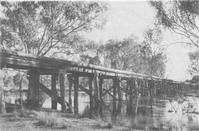


Chapter 6
I Construction During The Settlement Years
II The Use Of Timber As A Structural Material
III Structural Steel
IV Concrete Technology
V Housing
VI Industrialised Pre-cast Concrete Housing
VII Ports And Harbours
VIII Roads
IX Heavy Foundations
X Bridges
XI Sewerage
XII Water Engineering
XIII Railways
XIV Major Buildings
XV Airports
XVI Thermal Power Stations
XVII Materials Handling
XVIII Oil Industry
XIX The Snowy Mountains Scheme
XX The Sydney Opera House
XXI The Sydney Harbour Bridge
XXII Hamersley Iron
XXIII North West Shelf
Sources and References
Index
Search
Help
Contact us

From the time of the arrival of the First Fleet in 1788, Australians have been wrestling with the task of making effective use of the great range and number of timber species that are available in Australia. In the first year of the new settlement the local timbers were judged to be 'of little use, not fit for building either houses or boats'. However, within twenty years this judgement had changed markedly and Governor Philip Gidley King could declare that 'iron and stringybarks are well adapted to the different purposes where straight and durable timber is required' that 'box is a very fine timber' and that 'blue and blackbutted gums are esteemed woods'. There are more than 600 species of forest timbers that are available for structural purposes in Australia and a knowledge of their structural properties and natural durability has been gradually acquired through the years. Many of the local timbers have turned out to be far stronger and more durable than the timbers growing in Europe and North America. For example grey ironbark (Eucalyptus paniculata) is not only more durable, but twice as strong as English oak.
During the first fifty years of settlement wood was the prime structural material. Although there existed little formal engineering expertise at the time, some very remarkable buildings were constructed. For example, in Sydney there still survive in good condition, several large buildings, such as store buildings up to four storeys high, which were constructed of wood in the 1840s. In these buildings load transfer at connections is either through direct bearing or through mortice and tenon joints. Steel connections were used essentially only as locating devices.
The following period of 1840-1900 was probably the most exciting era for timber engineering in Australia. Armed with the imported technology of structural mechanics and urged by the railways to span wide rivers, the engineers of the time designed and built numerous remarkable bridges. Timber planks, mechanically laminated together by bolts and straps, were used to construct arches spanning up to 30 metres. For larger crossings, multiple girder spans of about 10 metres were commonly used; the longest bridge of this type was across the Murrumbidgee at Wagga Wagga, where the sum of the timber spans totalled 2800 metres. Another simple long timber bridge built across the Kiewa River at Bandiana is illustrated in Fig. 5. Other remarkable structural uses of timber during this period were to be found in the development of power and communication networks, wharves and jetties, and, of course, public buildings.

Around about the turn of the century, timber lost its pre-eminent position as a structural material. This was partly due to the fashionable attraction of the new structural materials such as wrought iron and reinforced concrete, and partly due to problems related to the maintenance and durability of timber structures sited in exposed locations. Timber continued to be used for the frames of house construction and by 1920 the light weight 'balloon frame' of North America had been widely adopted. These frames were not, however, engineered in the normal sense, and as a result no distinctions were made between the members, sizes required for frames of imported softwoods such as Oregon, and those for frames constructed from the superior Australian hardwoods.
Organisations in Australian Science at Work - CSIRO Division of Forest Products
People in Bright Sparcs - King, Gov. P. G.; Leicester, Dr R. H.
 |
Australian Academy of Technological Sciences and Engineering |  |
© 1988 Print Edition pages 318 - 319, Online Edition 2000
Published by Australian Science and Technology Heritage Centre, using the Web Academic Resource Publisher
http://www.austehc.unimelb.edu.au/tia/317.html